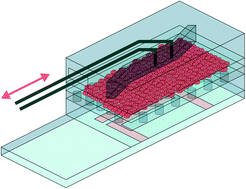Spatial trans-epithelial electrical resistance (S-TEER) integrated in organs-on-chips†
Abstract
Transepithelial/transendothelial electrical resistance (TEER) is a label-free assay that is commonly used to assess tissue barrier integrity. TEER measurement systems have been embedded in organ-on-a-chip devices to provide live readouts of barrier functionality. Yet, these systems commonly provide the impedance values which correspond to the highest level of permeability throughout the chip and cannot provide localized information on specific regions of interest. This work introduces a system that provides this essential information: a spatial-TEER (S-TEER) organ-on-a-chip platform, which incorporates moving (scanning) electrodes that can measure electrical resistance at any desired location along the chip. We demonstrate the system's capacity to obtain localized measurements of permeability in selected regions of a cell sample. We show how, in a layer with non-uniform levels of cell coverage, permeability is higher in areas with lower cell density—suggesting that the system can be used to monitor local cellular growth in vitro. To demonstrate the applicability of the chip in studies of barrier function, we characterize tissue response to TNF-α and to EGTA, agents known to harm tissue barrier integrity.



 Please wait while we load your content...
Please wait while we load your content...